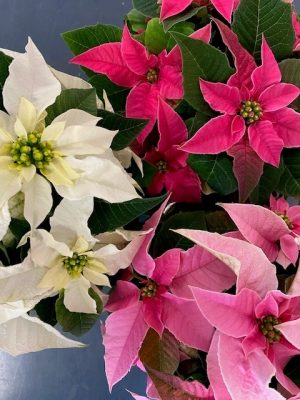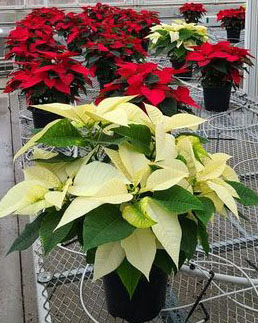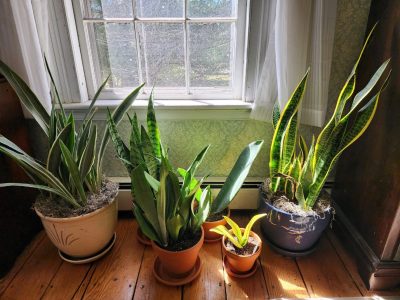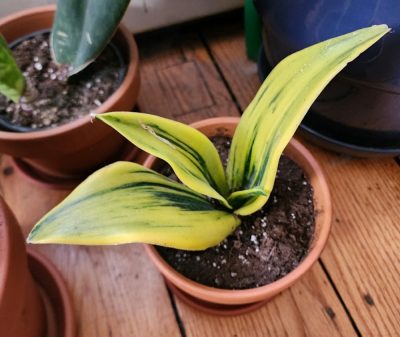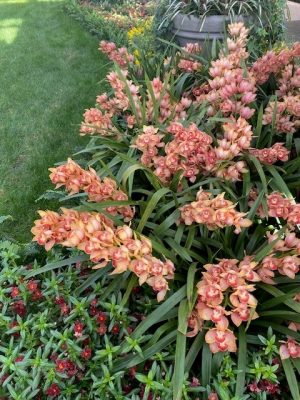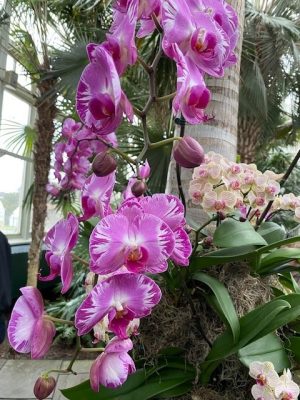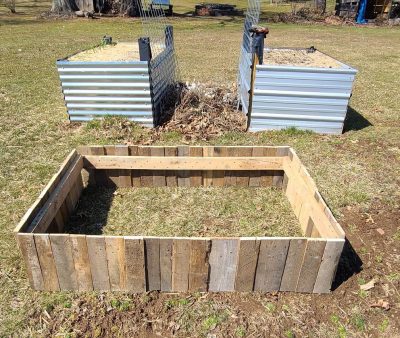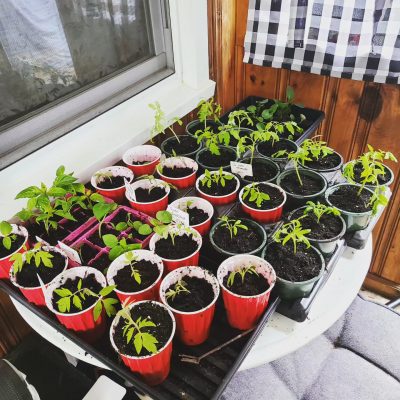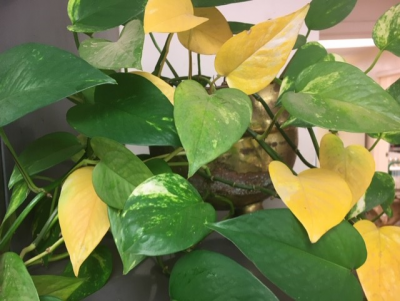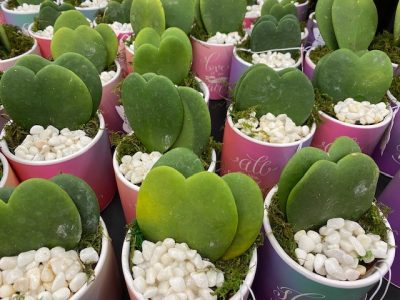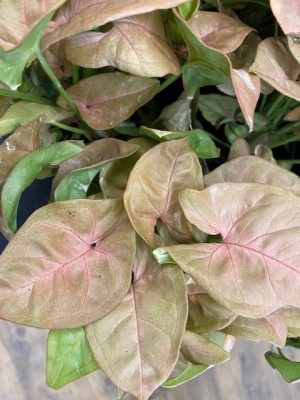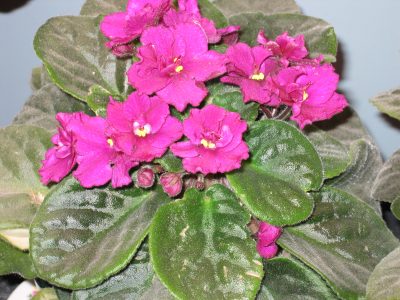00:00:00 Stephen Thal
Hi, welcome to another segment on Focal point. This is Stephen Thal and I'm going to be your host for today's program.
00:00:09 Stephen Thal
But before we get into it, I just want to remind if any of our listeners have any suggestions for future programming. Please call CRIS Radio at 860-527-8000 and leave your suggestions here and they'll pass them on to me and we'll try to get them for future programs.
00:00:28 Stephen Thal
So today we're going to be getting some great information on horticulture plants that have done a lot for people and here to help us out is Heather Zidack and she's the horticulture consultant for the UConn Program at the University of Connecticut and it's the Department of Plant Science and Landscape Architecture. So welcome, Heather.
00:01:03 Heather Zidack
Thank you so much for having me today.
00:01:06 Stephen Thal
Yeah. Today I'm going to learn as much as most of our listeners cause this is a program I used to use many years ago when I had a garden, but it's been so long, I'm sure there's been a lot of new changes going on right now.
00:01:20 Heather Zidack
Yeah, there's been a lot of new trends in gardening and the Home and Garden Education Center here at UConn has done a lot to help Connecticut gardeners with all sorts of problems that they've had, you know, plant identification, bug identification and also just we get pictures of plants all the time that say what's going on to help people kind of troubleshoot their issues as well as a lot of the things that we put out to help gardeners.
00:01:45 Heather Zidack
So. Everybody in our office loves gardening and we're here to help.
00:01:50 Stephen Thal
Yeah, that's great. It sounds like we're going through one of the health programs to viral.
00:01:55 Heather Zidack
Yeah. Yeah. We really enjoy what we do here and there's a few of us in the office. We work with the UConn Soil Lab, the UConn Plant Diagnostic lab and the extension program with Master Gardeners. So we have all the - all the resources to help people figure out what they want for plants if they're trying to figure out finding the right plant for them and also what to do once they have them. So I think it will be a good thing to talk about today what we like about gardening.
00:02:24 Stephen Thal
Ok. Because I think that you're making plants sound like people with the individual personalities.
00:02:31 Heather Zidack
Sometimes they are a lot of times people you know, they say gardening has so many benefits. They say plants are the new pets, right? That's one of the things that I've been hearing. And with that it's something that a lot of people have found to be very beneficial though.
00:02:46 Heather Zidack
Through there's actually programs of horticultural therapy out there. They found that it improved physical and mental health. It can reduce stress, improve your mood, it can even help with blood pressure and muscle tension. Not to mention it's great exercise to be outside with your plants.
00:03:02 Stephen Thal
And I'm sure the same is similar somewhat with plants inside the home.
00:03:07 Heather Zidack
Absolutely. People that have plants inside their home. Found benefits of, you know, cleaning air quality and things like that, but also it's great to just have your plants there, a lot of people, myself included talk to their plants every Sunday when they water or whatever it is and it's just nice to have a little bit of green especially in these cold winter months.
00:03:29 Stephen Thal
Oh yeah, and I'm sure by doing that you end up benefiting in the long run.
00:03:34 Heather Zidack
Absolutely, it's a great thing to have. You know, if sometimes it is kind of like having someone to talk to. As silly as that is, we have a plant here in the office. Named Harry and it's a Fern. And we take care of it all the time. And we're always seeing how he's doing and if he's gotten any bigger, it is kind of like having a pet.
00:03:54 Stephen Thal
Well, let's learn a little bit about the home and garden program, the Education Center.
00:03:58 Heather Zidack
Yeah. So at the at the home and Garden Education Center, one of the big things that we do is not only answer questions with horticultural advice, but we also do kind of put out fact sheets. We have a blog, we have social media where people can learn tips and tricks throughout the week about gardening.
00:04:18 Heather Zidack
And with all of the questions that we've had come in, I thought it would be a great chance for me to share with you some of the common questions we're getting right now, especially about house plants.
00:04:29 Stephen Thal
OK.
00:04:37 Heather Zidack
So one of the first questions that that comes along at this time of year is common signs of stress and what to do?
00:04:38 Heather Zidack
So sometimes at this point in the year, your plants not looking so well maybe and I've done this before, you've forgotten to water it for a couple of weeks over the winter or even over the summer. And the initial response is to love it and give it more water and give it attention. And when we start to baby them sometimes we can actually over water. And then it doesn't look like it's getting better because what often happens is plants can only communicate in one way, and that way is through wilting. So when it wilts, it could be that it needs more water, or it could be that it's getting too much water. So the best way to learn which one it is is to know the species of your plant. And you also need to take a look at the soil itself and feel it if it feels like it's too wet. If it feels like something, you wouldn't want to stick your hand in. It's probably too wet for the plant, and so that's some ways that you can kind of work through that issue. And try to make sure that you're not over watering, especially when something's dried out for too long.
00:05:43 Stephen Thal
So in terms of the soil lab, when do you send the soil up to you people to evaluate?
00:05:50 Heather Zidack
So our soil lab, they take samples for a lot of outdoor things instead of the house plants. But the best time to do it is either in the spring or in fall. If you do it in the fall. Sometimes there can be a little bit quicker of a turn around time because it's not on as many people's minds.
00:06:06 Heather Zidack
So that's the pro tip right there. If you send it in now, you do get a response and they give you all sorts of information about nutrition as well as how much you might need to put onto the soil to help it get back to that optimal level. So it's a good way to find out what you need and what you have.
00:06:25 Stephen Thal
We'll be giving the address and everything towards the end of the program as to where they can send it.
00:06:30 Heather Zidack
Yes, I can do that absolutely.
00:06:32 Stephen Thal
How do you do plant diagnostics?
00:06:35 Heather Zidack
So plant diagnostics is a is a fascinating thing that not everybody knows that we have here the way that it really works out well is people send in their plant samples. And sometimes something will look sick or it will be caused by something other than the environment. And it's hard for us to see that with our eyes. And sometimes we need to send in that sample to see what it is going on inside the plant. So our plant diagnostic lab does all sorts of microscope work. They do a lot of chemical tests and strip tests for different diseases of the plants, and they also they know what to look for with symptoms and location and are able to advise. Kind of. The next steps to take if you do have something that's diseased, we help out both commercially and homeowners themselves to learn what's going on with the tree, what's going on with the shrub, what's going on with crops that are being grown, and how to how to manage them. So it's a really cool thing that we have here as well and I can give you their contact information too.
00:07:42 Stephen Thal
How about the UConn extension Master Gardeners program?
00:07:47 Heather Zidack
Yeah. The UConn Master Gardener program is also a really good resource. One of the benefits that they have is that there is an extension office in every county of Connecticut and you're able to connect with a master gardener. They are a group of individuals who every year there's a new class. They go through a training program and learn how to become a master gardener. And they learn a lot of the things that we talk about here in home and garden as well, where it's soil conditions and plant selection and how plants grow. They learn all of those different things.
00:08:26 Heather Zidack
And they actually work with the public to help them understand them as well as part of a community outreach project that they each have to do. So it's a great program for people in Connecticut to either, if they love gardening, to pursue it further and get that master gardening title for themselves. Or to go to as a resource. And like I said, it's great that there's one in every county in the state.
00:08:52 Stephen Thal
Well, that's good. So how do you find their number?
00:08:56 Heather Zidack
So they actually go through UConn Extension Master gardener. You can find their website and you can find it through that or I can give you their number as well.
00:09:08 Stephen Thal
Ok. Why don't we take a break and let's give out some of the phone numbers for these programs we just talked about?
00:09:15 Heather Zidack
Fantastic.
00:09:16 Stephen Thal
OK, so the first program would be soil samples.
00:09:21 Heather Zidack
Yes. So our soil lab can be reached at 860-486-4274, 860-486-4274. That's for the soil nutrient analysis laboratory.
00:09:40 Stephen Thal
Right. And how about the plant diagnostics lab?
00:09:44 Heather Zidack
So the plant diagnostics lab works with our office as well, and you can call for plant diagnostics or for the Home and Garden Education Center at 860-486-6271, 860-486-6271.
00:10:05 Stephen Thal
And how about the UConn extension and master gardener?
00:10:09 Heather Zidack
The Master Gardener program can be reached at 860-486-7178. Again, that's 860-486-7178.
00:10:23 Stephen Thal
So there you have some phone numbers to call and educate yourself. How to help make your plants stay healthy and to really give you some benefits. I know my wife has found some plants in in the garbage and she's taken them and replenished them. And then now growing great.
00:10:44 Heather Zidack
Yeah, a lot of people are able to revive plants after they've they've taken a little bit of a hit. It's amazing how forgiving plants can be. Sometimes we see them and they haven't been watered for too long or they're they've been in the wrong condition and it's just a matter of taking care of something. And again, that leads into one of the benefits where there's a sense of pride of I brought this back. Or I've really accomplished something with what I've done, sorry.
00:11:12 Stephen Thal
Now with plants, I'm just curious, do you have to have good vision to have a plant so you know it's getting in bad shape?
00:11:20 Heather Zidack
Not necessarily. There are a lot of things that you can learn through feel when you're working with plants. Sometimes if you feel the leaves especially. If you're feeling if you have succulents, for example, there are very popular house plant that people will have on windowsills and in their offices and things like that. And with succulents you can actually tell if they need water by the feel of the leaf. If you pinch a succulent leaf and feel the leaf between your fingers. It's actually, it should feel firm and a little bit smooth to the touch.
00:11:58 Heather Zidack
If it needs water. They get a little bit squishy and a little bit rubbery, and so that's how, you know, maybe it needs some water. At this point. The other thing that you can do is you can feel the soil to tell if something needs water or not. The other thing that you can do to assess health of a plant is feel the leaves of themselves and if there's ever a crunch, you know that's a bad sign and that there's something going on. Either disease or possibly just watering. And you also can tell the differences you're feeling. If there's been any issues with like chewing marks you can feel a lot of times. Insects will leave a sticky residue so you can tell what's there. So there's a lot of senses other than vision that are involved when it comes to looking at your plants and their health.
00:12:45 Stephen Thal
Yeah, that's good to know. Because uh, some of our people may not be able to see the plants, but they really enjoy having them around in the house.
00:12:56 Heather Zidack
Absolutely. It's one of those things that the plants are multi sensory and so we're able to kind of understand them through more than just vision.
00:13:06 Stephen Thal
And you mentioned the word succulent. What are some examples of succulent plants?
00:13:12 Heather Zidack
So a succulent plant is kind of an overarching group. They are all of the ones that love to be in dry conditions a lot of times they are. They are not cactuses but they end up being lumped into that group where they like those drier conditions. They tend to be the ones that look like little rosettes. Or little mounds on the soil that will grow from there. They're very I. I talked about the rubbery texture. They some of them almost don't seem real when you feel or see them because they have this this very strange look to them. So they're a very popular plant because they're so easy to take care of and they're also very unique in their appearance.
00:13:57 Stephen Thal
This is Stephen Thal and another focal point program and we're interviewing Heather Zidack and she's from the UConn Extension program and we're learning about what that program is all about. There are several programs and we've shared some phone numbers earlier and she's educating us on more and more and how we. And be with the plants, enjoy them and have fun with them. What are some of the other benefits of the plants?
00:14:30 Heather Zidack
So another great thing with having your plants is like I said, that sense of pride and accomplishment and what you've done or what you've been growing and producing. So it's something that it gets you outside. If you have an outdoor garden or even if you're inside it has you proud of what you've accomplished, some people grow vegetable gardens. And they are so proud of all the produce that they grow and what they're able to do with that. So there is a sense of pride and joy that comes with gardening. There is exercise benefits, there's all sorts of great things that come with working with plants and being part of that. You're connecting with nature. So it's always a great thing to be able to connect back to nature.
00:15:14 Stephen Thal
And also they have found that it helps people reduce stress.
00:15:19 Heather Zidack
Yes it can. It can reduce stress. It can reduce blood pressure. It can help with your pulse and help bringing your heart rate down and muscle tension. It's a great way to take a break from everything else you know, being even from personal experience, when I'm able to go out into my own garden or transplant my house plants or plant my seedlings, it's a break from everything else that's going on. We get very busy with our lives and being able to take that break and go garden.
00:15:53 Heather Zidack
Or go, you know, take 5 minutes to just take a breath and trim some plants. It's a great way to de-stress.
00:16:02 Stephen Thal
In terms of fertilizers, how do you know which one to use for different plants?
00:16:10 Heather Zidack
Usually picking a fertilizer can be a little tricky. You have to know what species of plant that you're working with, and then you're able to figure out from there. And that's something that we would be able to help with for sure.
00:16:23 Heather Zidack
In general terms, plants need three big things to be able to grow. They need nitrogen, phosphorus and potassium. And so when you're looking at fertilizers, a lot of times you'll see that there are three numbers there and they're always like in increments of five or ten, like it says 5-5-5, 10-10-10, 20-10-20 those are all ratios and a balance of those three main nutrients. Your first number is nitrogen and then phosphorus and then potassium. And in general terms of balanced fertilizer is always the best way to go.
00:17:01 Heather Zidack
Those different elements can encourage flowering versus root growth versus leaf growth. But when you're trying to take care of the plants that you have, that balanced fertilizer makes sure that you're getting enough fertilizer and enough nutrients to the plant in a balanced way.
00:17:21 Heather Zidack
Our clients that go through our soil lab, they get specific recommendations based on what they have for soil and what they're looking to grow.
00:17:31 Stephen Thal
Let's take a look at some of the common questions you get from your constituents. So what are some of the common signs of stress and what to do?
00:17:41 Heather Zidack
Yeah. So with stress, with plants, it's one of those things where like I said they have-They only have one way to communicate, and that's through wilting. They can change color as well, but wilting is really that big flag of communication and so they can wilt if they're overwatered, they can wilt If they're underwatered. They will also change colors at times and so that makes it difficult for us sometimes to know what's going on.
00:18:09 Heather Zidack
When you're looking at stress, if you have a plant that is wilting, or if you have a plant that is feeling spongy like I had mentioned before, it doesn't feel like it's firm. And the way that it should be, the first thing you want to look at is watering, so make sure that you have enough water in the soil. It's not too dry, it's not too wet. That's a good thing to start with. Additionally, you can start looking at the conditions around it. So one of the things is sometimes you.
00:18:40 Heather Zidack
Look at it and you think would I be happy sitting in this spot? So is it getting enough light? Is it getting a draft from the window near it because it's getting a little bit colder than it should be. A lot of house plants that we have come from tropical regions and so they want to be warm. They want to be they want to have a little bit of humidity and they want to have the right amount of water so. Taking a look at them and saying is this the spot for this plant is a way to kind of look at the stress and manage it.
00:19:13 Stephen Thal
What are some of the other questions that people are asking in terms of the plant itself?
00:19:19 Heather Zidack
Another question that we get a lot of the time is the question of “is it dead?” We get pictures of plants and people are worried that they have killed their house, plant or even sometimes plants outside. And one of the things with plants that you need to be aware of is that some of them can go through a process called dormancy. It's a lot like hibernating in the winter, and when they go through dormancy. You notice this with trees outside. They drop their leaves, they get kind of gray looking. They don't look like there's a lot of life in them. And so in that dormant state, one of the ways that we can see if they still have life in them is to go ahead and scratch the surface of the stem.
00:20:07 Heather Zidack
And if you are able to see it, you'll see that there's some green or whitish tissue in there, and that that means that there's life in the stem. Still, if you struggle to see it, you should feel a difference and that it will catch on your fingernail instead of just being a dry break. And so if you feel that where it's catching. Then it's actually there is some life there and it means that it's going to come back from dormancy now, that's where things with woody stems. If there's plants that are dying back all the way to the ground, it's really hard to tell. Is it dormant or is it not? And a lot of times, we recommend just giving it time.
00:20:46 Heather Zidack
Sometimes plants nap a little bit longer than others, and so it's really important to give them their time to make sure that they've come out of dormancy. This goes for both house plants as well as plants in the ground. There are some perennials here in Connecticut that don't even start waking up until after Memorial Day in May and so give it time. Have a little patience. There might be some life there. It's just a matter of waiting for it to come back.
00:21:14 Stephen Thal
I think another question is do you have recommendations of house plants?
00:21:18 Heather Zidack
Yeah, another. That's another question that we get a lot and it's different recommendations of what to grow for varieties. And so I actually have a list here for you of house plants that have varieties and texture, scent, color and movement because who wants to have just green plants around, right? We have so much selection now in the plant world that it's really awesome that we can bring some interest into our plants. One of the first ones that I always love to recommend is it's called a prayer plant or a calathea. What they do is they will either curl their leaves or bend them up and down depending on what time of day it is. So.
00:22:02 Heather Zidack
It adds a little movement. They tend to have a lot of bright colors to them. My personal favorite is called rattlesnake calathea. And it has some really big spots on it. Purple underside to the leaf, and it'll actually fold its leaves straight up in the air at night, and then during the day those leaves will come down to get the sunlight. So it's really cool to add some movement. Another thing that people like to do is they have some scent in their house plants, so adding scented geraniums, those are a type of geranium.
00:22:39 Heather Zidack
It's related to the ones that we see all year in the summer. However, it's different in its flower and also in its scent. When you touch it and move the leaves you get a really nice scent out of them. Some are peppermint, they have apple, they have lemon, they have all sorts of different geranium scents, so if you start looking for scented geraniums, that's a really cool way to add some fragrance into your house plant garden. Another really good plant to have is the sensitive plant. It's as its name says, it's a little sensitive and that whenever you touch it, it will recoil and those leaves will drop right down. And it takes maybe 10-15 minutes for them to recover and open, back up and then they will do it again.
00:23:28 Heather Zidack
The sensitive plant is a really cool thing that I used when I was working in the garden center. We would use it in fairy gardens and children absolutely loved to be able to touch it and have it actually move. It brought more life to that little garden that they created. Another one is called the Chenille plant.
00:23:48 Heather Zidack
Where it has fuzzy fuzzy flowers, they feel like little rabbit feet and they are bright red so you can grow it as a hanging basket. You can grow it in a little pot as a house plant where you can put it outside during the summer. So it's a really versatile plant that adds some texture and brightness and like I said, they're very fuzzy. It's one of the wildest ones that I've seen. There's another called a Tricolor Stromanthe that is green, cream, and pink and the leaves have different colors all year long. So it's another nice way to get away from just green house plants. And then lastly, the other one that is a good conversation starter at the very least.
00:24:29 Heather Zidack
Is the carnivorous plants or the cacti that can add interest and they can add texture and it's just like I said, a conversation piece of “Wow, what is that?” And it's a Venus Flytrap that will close up when touched by flies. Or there are some pitcher plants out there that also attract insects that are carnivorous as well. So it's just a cool way to add something to your collection that's not just green and it adds texture and scents and really involves all the.
00:25:00 Stephen Thal
And we have a few minutes left in our program and I was wondering if you could make suggestions on where people can buy plants and how they can tell they're making sure they're getting a good plant without disease, without flies or whatever else.
00:25:14 Heather Zidack
Yeah.
00:25:17 Heather Zidack
Yeah. So we always recommend shopping local when possible. And so there are independent garden centers in the state that offer a wide selection of plants. However, there's also a lot of hardware stores and box stores that you can get good material at as well.
00:25:35 Heather Zidack
When you're looking for your plants, it's the plant itself that you want to make sure it's healthy, more so than where you're shopping. So taking a look, feeling that soil, like I said, if it's bone dry, chances are it hasn't been watered in a minute. And maybe that could affect the plant itself.
00:25:55 Heather Zidack
Use some of those senses that I've talked about previously where you're feeling the leaves and feeling for some crunch. Or really if they're succulents, getting a feel of that leaf to make sure that you're aware of what it feels like. Some people will bring home plants to rescue. But if you want a nice lush plant, start with that. Don't look at something and feel like oh man, this is a little bit rough and I could save it if you want to start strong, start with a plant that is healthy. There's no spots, there's no tears.
00:26:27 Heather Zidack
If you feel any chew marks, if you're able to see the roots, sometimes you see roots growing out of the pot. Check that they're not black and mushy. Make sure that they're white and firm.
00:26:41 Heather Zidack
And really, most plants from from garden centers are going to be in pretty good shape and they'll thrive with care. So really it's about the plant and make sure it's healthy when you start and then just do your best to take care of it once you get it home.
00:26:56 Stephen Thal
And I noticed that there are a couple of areas that we didn't mention quickly, like herbs are good to do.
00:27:02 Heather Zidack
Yes, yeah, herbs are great.
00:27:06 Heather Zidack
If you're doing, especially if you're doing a container garden or raised bed gardens, herbs are really great to mix with your flowers. The nice thing is that herbs will add a little bit of scent and use. You can actually harvest them and use them in your cooking in addition to the container plants that you have. So we recommend that with a lot of outdoor containers, more so than indoor. However, if you're growing herbs indoor, just grow them separately from your other house plants.
00:27:37 Stephen Thal
And also the sunlight is important too, because some plants don't like sunlight all the time. Some do.
00:27:44 Heather Zidack
Right. Yes. So sunlight is one that can be tricky too, and I explained that if you think about if you've had a cat and you understand how cats behave, plants can kind of feel the same way. So anything that requires direct sun or full sun.
00:28:00 Heather Zidack
If you think about a cat laying in the sun on a on a nice warm day and it's right in the window where it can get that sun. That's what direct sun is. It has to be in contact with the leaves for six hours a day or more. If anything asks for indirect sun, that means that the sunlight doesn't directly contact the leaves but it likes to be able to be somewhere that it can see that light for six hours or so a day. That's kind of like your cat that sits near the window and watches, but maybe that spot in the direct sun is a little too warm for him. So he shifts over a little bit.
00:28:37 Heather Zidack
And then you have shade and with shade. The sun does not make contact with the leaves at all. That's kind of your cat that's going to hang out on the couch and doesn't care too much about being near the window at all. So that's a really good way to remember direct sun, indirect sun and shade is kind of where does that cat like to hang out?
00:28:56 Heather Zidack
It's kind of funny, but it works.
00:28:58 Stephen Thal
Do you have any final recommendations for our listeners?
00:29:02 Heather Zidack
My biggest recommendation is to just get out there and garden. You know, we talked today about some of the best benefits of gardening and working with plants. And don't be afraid. It's one of those things that's really great to do. And don't say I don't have a green thumb. You can do it. You just need to maybe get a little bit of advice and we can offer that here at the garden Home and Garden Education Center, but maybe you just need to do it and say I did it, so get out there and garden.
00:29:35 Stephen Thal
Heather, why don't you leave your phone number in case people want to talk to you directly.
00:29:41 Heather Zidack
Yeah. So I can be reached at the Home and Garden Education Center and my number here is 860-486-6271, 860-486-6271.
00:29:57 Stephen Thal
It has been very interesting. We've given out a lot of information and we hope that our listeners will take you up on it, call you and if they need more information. Ohh. One other thing I forgot to ask, is there a cost involved for the soil samples and all this sort of thing?
00:30:14 Heather Zidack
So for soil samples there is a cost.
00:30:17 Heather Zidack
For our plant diagnostic lab, if a sample needs to be submitted, there is a cost. However, working with the UConn and home and Garden Education Center, our advice is free and we will also if you if clients e-mail us pictures, we can kind of take a look and get the ball rolling and sometimes we can we can make a determination from a picture, so advice that comes out of the office that I'm in is free.
00:30:41 Stephen Thal
We appreciate your coming on and we'd love to get you back in the fall. So give us a call, call me like in August.
00:30:49 Heather Zidack
Yeah. Thank you for having me.
00:30:50 Stephen Thal
And let's see if we can get you back in, whether you come in September or October, you let me know and we'll work it out with the studio in terms of, yeah, having you get involved.
00:31:00 Heather Zidack
That would be great. Thank you for having me.
00:31:02 Stephen Thal
Yeah, it's a pleasure. You know, we try to cover a wide range of things for our listeners and we know that some of our programs really move the people forward and get some things done that they like.
00:31:14 Heather Zidack
That's fantastic. Yeah.
00:31:16 Stephen Thal
So we want to thank you. This is Stephen Thall with another segment on focal point. We want to thank everyone for allowing us into your homes. Couple of last minute comments first.
00:31:25 Stephen Thal
Please wear your sunglasses and a hat during these days when you're outside with the sun because it's protects your eyes and the second thing is develop an emergency plan at home and practice it. And when you're traveling, make sure that you go to places where there's at least two exits. So in case one is blocked, you can get out the other door.
00:31:48 Stephen Thal
So again, thank you all for listening. Stay safe, stay healthy.
